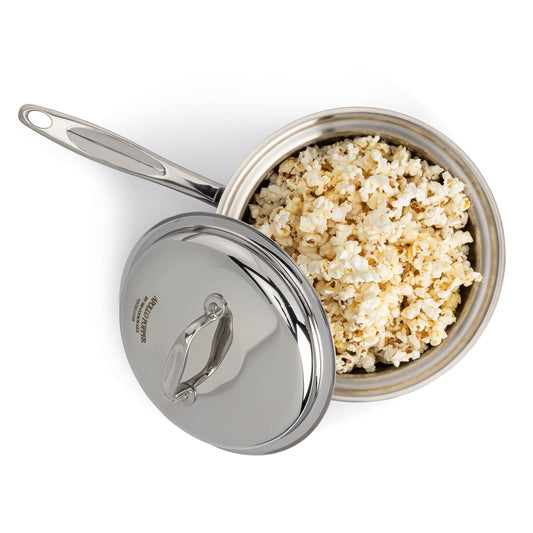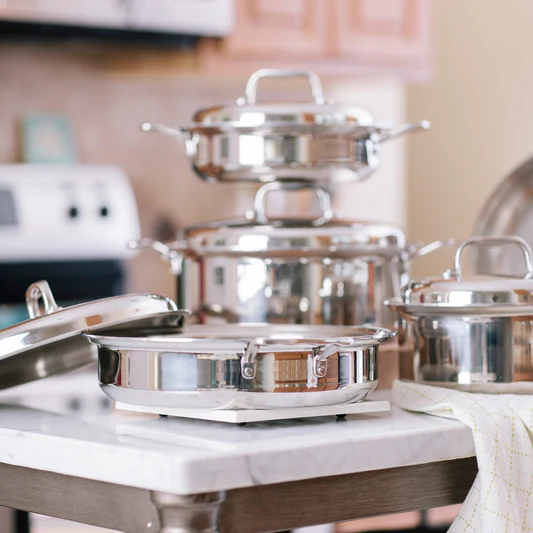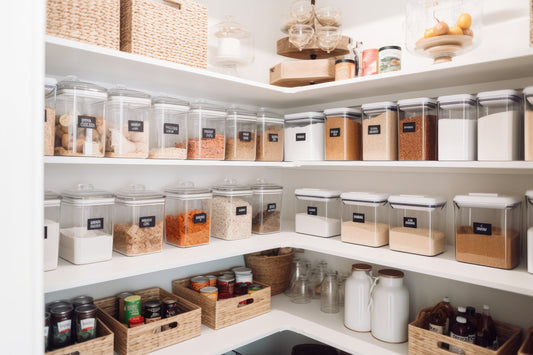Choosing the right cookware is an investment that can last you a lifetime, as quality pots and pans are an investment that could easily last you a lifetime. When considering whether stainless steel or cast iron is the right choice for you, you should look at their performance on the stove and how easy they are to maintain in good condition before making your purchase.
Creating a Non-Stick Cooking Surface
Cast iron is notorious for being high maintenance. To begin with, it needs to be treated before being used. Seasoning a cast iron pan with oils at high temperature creates a relatively non-stick surface for frying and searing. However, that seasoning can be stripped away by incorrect use, and even under normal conditions it’s recommended that a cast iron pan be seasoned once a month or so. It’s also a good idea to wipe a pan with a thin layer of oil after each use.
On the other hand, stainless steel cookware is ready to use right out of the box! You can create a non-stick surface by heating the pan for several minutes at medium heat, and then adding cooking oil or butter to the surface before the food.
Which is most versatile?
While cast iron pans are lauded for searing meats and frying to perfection, there are some cooking tasks that they are not as well suited for. Because cast iron will react to acidic foods, if acidic ingredients such as tomatoes are cooked in a cast iron pan, will leach out of the pan and impart a metallic taste to your food. As well, since cast iron is porous and can retain flavors from previous meals, you may end up with a dish that tastes off.
Stainless steel is completely non-reactive, making it a safer choice for any food that is highly acidic. That includes tomatoes, vinegar, and citrus. On the other hand, stainless steel also does an excellent job at searing meats and frying, making it a better all-round choice. Look for stainless steel cookware that can be used in the oven as well for even more versatility in the kitchen.
Temperature Control
Cast iron cookware, because of its weight, takes longer to heat up but also holds heat better. That’s an advantage if you’re cooking a stew on the back burner, or deep frying where the hot oil needs to maintain a certain temperature, but will be a problem if something starts burning. Even if you quickly turn the burner down or off, the cast iron itself will stay hot for much longer than a thinner, lighter pan. Cast iron also doesn’t heat up uniformly, with hot spots that result in uneven cooking.
Stainless steel, because it is thinner and lighter, will heat up faster. 360 Cookware has a middle layer of aluminum for the best heat conduction, ensuring even cooking. As well, stainless steel pans will also cool down more quickly. If something is browning too quickly in a stainless steel skillet, removing it from the heat will drop the temperature more quickly and save the food from burning.
Weight and portability
Cast iron cookware is thick and heavy, which is why it holds heat so well. However, a big cast iron pan such as a large skillet or dutch oven can become difficult to work with, especially for someone without a lot of strength. Lifting a pan to pour out its contents can be a struggle, and you are more limited in storage options compared to other types of cookware that aren’t as heavy.
Stainless steel is thinner and lighter than cast iron, and so is much easier to handle, even when full of food. It’s easy to store even on hooks or wire racks, giving you more organization options in any kitchen.
Everyday Maintenance: Stainless Steel Wins
Once you’ve finished cooking, there are some important things to keep in mind when cleaning a cast iron pan. First of all, there is no scenario where putting it in the dishwasher is possible. The detergents will strip the seasoning and you’ll end up with a rusty pan that will need to be restored before being used again. In fact, even using dish soap when hand washing a cast iron pan is discouraged. Sometimes a brief soak in hot water to loosen cooked-on bits is okay, but for the most part, a quick scrub with a stiff brush or chain mail scrubber is sufficient.
Stainless steel can be put in the dishwasher without worry, making most clean-ups a breeze. If some food is stuck to the surface, soaking the pan in hot water can lift most of it off. For really stubborn burnt-on remnants, you can boil water with a scoopful of baking soda to loosen them.
Durability
Cast iron pans are legendary for their durability. Properly maintained, you can expect a good quality cast iron skillet to last your lifetime and beyond. Even one more than a hundred years old that has become rusted and unusable can be restored to good condition with some work.
Good quality stainless steel can last for decades, too. Because there’s no coating that can become scratched or chipped, the surface will remain in excellent shape with normal use. While slight discoloration may occasionally occur, it will not affect the performance or safety of the stainless steel.
Cooking Up The Results
So, in the end, which cookware is the better investment? Let’s review what we’ve learned!
Cast iron needs to be seasoned regularly to maintain a non-stick surface, while stainless steel has no maintenance required. While cast iron can become rusted when not taken care of properly, there is no risk of that with stainless steel. Stainless steel is non-reactive, while acid foods cooked in cast iron can leach iron. Stainless steel is lightweight for ease of use, and cools down faster for more precise temperature control. You can also wash stainless steel in the dishwasher, which is a big no-no for cast iron!
The choice is clear! Stainless steel cookware is the most versatile, low-maintenance cookware that you can buy.




